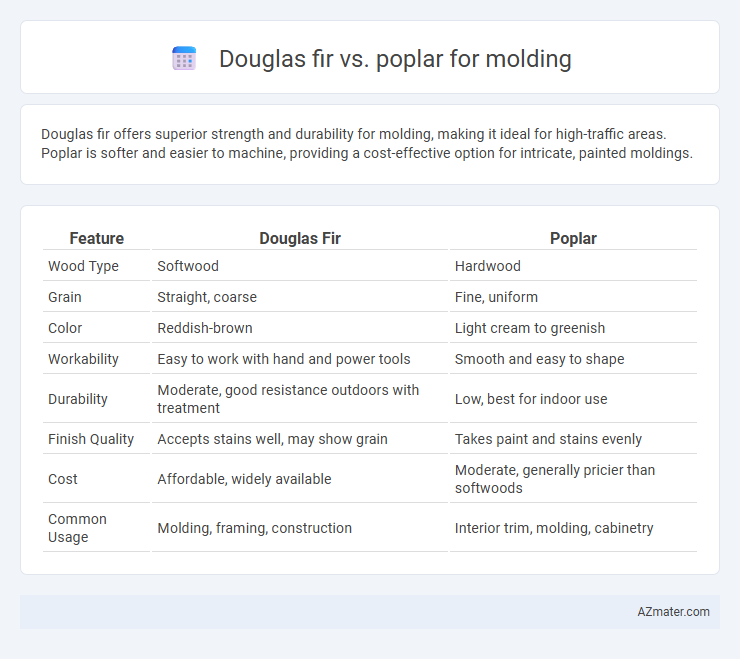Douglas fir offers superior strength and durability for molding, making it ideal for high-traffic areas. Poplar is softer and easier to machine, providing a cost-effective option for intricate, painted moldings.
Table of Comparison
| Feature | Douglas Fir | Poplar |
|---|---|---|
| Wood Type | Softwood | Hardwood |
| Grain | Straight, coarse | Fine, uniform |
| Color | Reddish-brown | Light cream to greenish |
| Workability | Easy to work with hand and power tools | Smooth and easy to shape |
| Durability | Moderate, good resistance outdoors with treatment | Low, best for indoor use |
| Finish Quality | Accepts stains well, may show grain | Takes paint and stains evenly |
| Cost | Affordable, widely available | Moderate, generally pricier than softwoods |
| Common Usage | Molding, framing, construction | Interior trim, molding, cabinetry |
Introduction to Douglas Fir and Poplar for Molding
Douglas fir is a durable softwood known for its strength and fine grain, making it ideal for sturdy and long-lasting molding applications. Poplar, a lightweight hardwood, is valued for its smooth surface and ease of painting, providing a cost-effective option for decorative moldings. Both woods offer distinct benefits for molding, with Douglas fir excelling in structural uses and Poplar favored for detailed, painted finishes.
Wood Characteristics and Appearance
Douglas fir offers a strong, durable wood with a straight grain and a warm reddish-brown hue, making it ideal for moldings that require structural integrity and a classic look. Poplar features a softer texture with a smooth, fine grain and a lighter, yellowish to pale green color, allowing for easy painting and customization on moldings. Both woods are versatile, but Douglas fir's hardness suits high-traffic areas, while poplar's workability benefits detailed, decorative trim applications.
Durability and Strength Comparison
Douglas fir offers superior durability and strength compared to poplar, making it a preferred choice for molding in high-traffic or impact-prone areas. Its dense grain structure provides excellent resistance to wear, dents, and warping, whereas poplar, being softer and less dense, is more prone to damage and surface imperfections. For long-lasting, robust molding installations, Douglas fir delivers enhanced performance suited to demanding environments.
Workability and Ease of Installation
Douglas fir offers excellent workability due to its straight grain and medium hardness, allowing for precise cutting and shaping without excessive wear on tools. Poplar, known for its softness and uniform texture, is easier to sand and paint, making it ideal for detailed molding projects requiring smooth finishes. Installation of Douglas fir molding benefits from its strength and stability, while poplar's lightweight nature simplifies handling but may require careful fastening to avoid dents or damage.
Cost and Availability
Douglas fir offers a cost-effective option for molding due to its widespread availability and fast growth, making it commonly stocked and affordable in North American markets. Poplar, while slightly pricier, is readily available and valued for its smooth grain and ease of machining, which can reduce labor costs in detailed molding projects. Choosing between Douglas fir and poplar depends on balancing initial material cost with desired finish quality and availability in your local supply chain.
Finishing and Paint Compatibility
Douglas fir offers a tight grain structure that allows for smooth finishing and excellent paint adhesion, making it ideal for detailed molding work. Poplar features a softer texture with a fine, even grain that readily accepts paint without significant preparation, resulting in a clean and uniform appearance. Both species provide good compatibility with various primers and paints, but Poplar typically requires less sanding to achieve an optimal finish.
Environmental Impact and Sustainability
Douglas fir offers superior sustainability due to its fast growth rate and abundant availability, making it a renewable resource with lower environmental impact compared to poplar. Poplar, while lightweight and easy to work with, often requires more chemical treatments that can negatively affect indoor air quality and sustainability certifications. Choosing Douglas fir molding supports responsible forestry practices and reduces ecological footprint through carbon sequestration and habitat preservation.
Common Applications in Molding
Douglas fir is favored in molding for its strength, straight grain, and fine texture, making it ideal for baseboards, window casings, and door frames where durability is essential. Poplar, with its smooth surface and ease of painting, is commonly used in interior trim, including crown molding and wainscoting, offering a cost-effective choice for decorative finishes. Both woods provide versatility, but Douglas fir excels in structural applications, while poplar is preferred for detailed, painted moldings.
Pros and Cons of Douglas Fir vs Poplar
Douglas fir offers superior strength and durability for molding, making it ideal for high-traffic areas or structural applications, but it has a coarser grain which can be challenging to finish smooth. Poplar is easier to work with and sands well, providing a smooth surface perfect for painting or staining, though it lacks the hardness and durability of Douglas fir. While Douglas fir resists dents and wear better, Poplar tends to be more affordable and readily available in uniform boards.
Final Recommendations for Choosing Molding Wood
Douglas fir offers superior strength and durability, making it ideal for molding in high-traffic or structural areas where longevity is critical. Poplar, being softer and easier to paint, excels in decorative moldings and interior trim where smooth finishes and intricate details are prioritized. Choose Douglas fir for robust, long-lasting applications and select Poplar when ease of machining and excellent paint adhesion are essential for aesthetic appeal.

Infographic: Douglas fir vs Poplar for Molding
 azmater.com
azmater.com